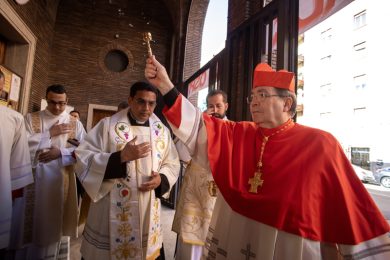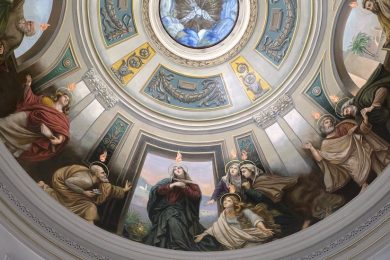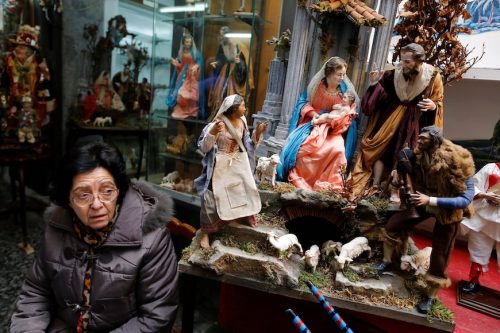By Emily Stimpson Chapman | OSV News
By American standards, the Via San Gregorio Armeno wouldn’t even qualify as an alley. Measuring perhaps 5 feet across, it’s barely wide enough for three men to pass through it abreast. Yet come Advent, the little street in Naples, Italy, welcomes thousands of visitors from around the country and around the world every day.
The visitors come not because the street leads anywhere, but rather for the street itself. Or, more accurately, for the shops that line the street — hundreds of tiny workshops, where artisans and their assistants craft the “presepe” for which Naples is known.
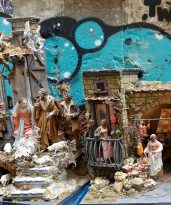
The Americans who visit are inclined to call the presepe Nativity scenes, but that doesn’t do them justice. They are much more than that. They are more than Mary, Jesus and Joseph. More than oxen, donkeys and sheep. More even than shepherds, angels and Wise Men.
The presepe are entire villages, with butchers, bakers and candlestick makers all going about the business of their lives while the newly born Christ Child sleeps in their midst. In the houses and shops of the presepe, fires burn and candles gleam. Bread appears to bake. Wine stands ready for pouring. This is no silent night, but rather a night filled with love, laughter and life.
The detailing of each and every piece of the presepe found along the Via San Gregorio Armeno is exact and minute, the work of artists who spend years honing their craft. The Neapolitans take their presepe seriously. For them, it’s more than art. It’s their heritage, part of their city’s life since the modern presepio first was crafted here in the mid-16th century.
In 1563, the Council of Trent urged Catholics to embrace the crèche as a particularly Catholic tradition (as opposed to the Christmas tree favored by Martin Luther). Neapolitan artist St. Gaetano is said to have been the first to answer the call, crafting the forerunner of the modern presepio. Other artists followed suit, creating elaborate scenes with richly dressed, life-sized statues for churches and convents throughout the city.
As the years passed, other artisans in Naples started making smaller scenes for private homes — scenes with multitudes of figurines and intricate moving parts. The passing of more years brought the incorporation of regional markers into the presepe, with life outside the stable where the Holy Family rested taking on the look and culture of the towns for which they were made.
Today, little has changed. The presepe crafted in Naples and distributed throughout Italy and around the world are much the same as the presepe crafted in Naples during Napoleon’s day. Technology has given the artists the tools to include electric fires and burning candles in their miniature masterpieces, but most of the materials used are as they were, crowded with life and embodying local culture.
In the seaside town of Sorrento, the presepio on display in the town square shows fishermen working on their nets, while a market sells the large lemons for which the town is known. The Roman presepe often feature aqueducts, pine trees and olive groves. Sicilian presepe include coral and alabaster, while Neapolitan presepe overflow with food — bread, fruit, roasts and wine.
The scene immediately around the manger, however, is almost always the same. Christ lies in his bed of straw, while his adoring mother and foster-father look upon him. The oxen and the ass are there too, as are the shepherds and the magi. That scene is the unchanging heart of the presepio. It witnesses to the miracle of love, grace and humility born in Bethlehem long ago, and it gives meaning and purpose to the whole riotous tableau to which it belongs.
But the riotous tableau isn’t incidental to the presepio.
The men and women who populate it, eating and drinking, working and resting, fighting and even making love, have a meaning as well. They have a witness to give.
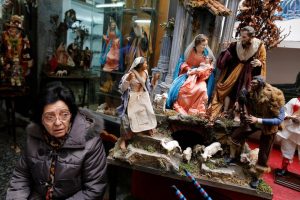
On one level, the varied figurines within the presepio remind us that the Incarnation isn’t an abstraction. God didn’t just become man. He became man in a specific time and place. When he was born, men and women were eating and drinking, working and resting, fighting and making love. On the night he first looked upon his Creation with human eyes, both political dramas and personal dramas were unfolding.
History records the political dramas — the intrigues of Caesar’s government and machinations of Herod’s court. The personal ones remain hidden. But they were no less real, and the representation of them within the presepio helps us see that God did indeed come into this raucous world of ours on a cold night 2,000 years ago.
The villagers of the presepio also remind us of how ignorant men were of the miracle transpiring in their midst. Love and existence himself had become incarnate and entered time to redeem and save his people, but except for a handful of shepherds and Wise Men, no one knew. They were busy worrying about their roast of lamb and the interest due on their loans, while God lay a stone’s throw away in a cradle of hay.
In that reminder there’s a reminder for us as well. It’s a reminder that we too have God in our midst — at every Mass and in every tabernacle — and should guard against neglecting that miracle because we’re too busy fretting about roasts and loans of our own.
Even more importantly, however, the presepio reminds us that even in the fretting about roasts and loans we’re called to encounter Christ.
Christ came into a busy world 2,000 years ago, and he comes into an even busier world now. But he didn’t and doesn’t come into the world to remain separate from the eating and drinking, working and resting, fighting and making love. Rather, he came — he comes — to enter into it all and transform it.
The Incarnation made it possible for Christ to atone for man’s sin and offer us the reward of eternal life. But it also made it possible for Christ to redeem the life we live now, to make every thing we do and encounter in these bodies of ours an opportunity to discover him, serve him and become more like him.
By not forgetting about the world into which Christ entered, those who pioneered the presepio, like the greatest of saints, demonstrated that they understood that. They understood that to become the men and women God made us to be, so much more is required than simply going to Mass on Sundays and confession once a year. To become holy, we can’t meet Christ just in the church. We can’t meet him only where he waits for us. We have to welcome him into our lives as well — into our homes and offices, kitchen tables and Facebook pages, the rooms where we make love and the rooms where we rock our babies to sleep.
That’s the call going forth from those Neapolitan presepe. It’s a call to live a life where we both see Christ in everything we do and see everything we do as a way to approach Christ. That’s a sacramental life. That’s a Catholic life. That’s the life to which we’re called in Advent, at Christmas and on every other day of the year.
What a world it would be if every tourist thronging the Via San Gregorio Armeno at Advent-time answered that call. What a world it would be if we answered that call.
– – –
Emily Stimpson Chapman is a bestselling Catholic author of nearly a dozen books, and a former contributing editor to Our Sunday Visitor. Her writing can be found at substack.com/@emilystimpsonchapman.
– – –
SIDEBAR: Nativity scene’s origins
Depictions of the world on the night of Christ’s birth are about as old as the church. The earliest known Nativity scene is painted on a wall in the catacombs of St. Priscilla. Dating to the first years of the second century, it shows the Mother and Child, St. Joseph and three Wise Men. Above them shines an eight-point star.
By the fourth century, carvings of similar scenes began appearing on the tombs and sarcophagi of Christians, with the oxen and ass included as well. Later, in 1223, St. Francis created a living crèche for Christmas Mass, situating a donkey next to a manger full of hay.
From there, the tradition of the crèche spread slowly, with increasing numbers of parishes keeping large statues of the Nativity in their side altars year-round.




